
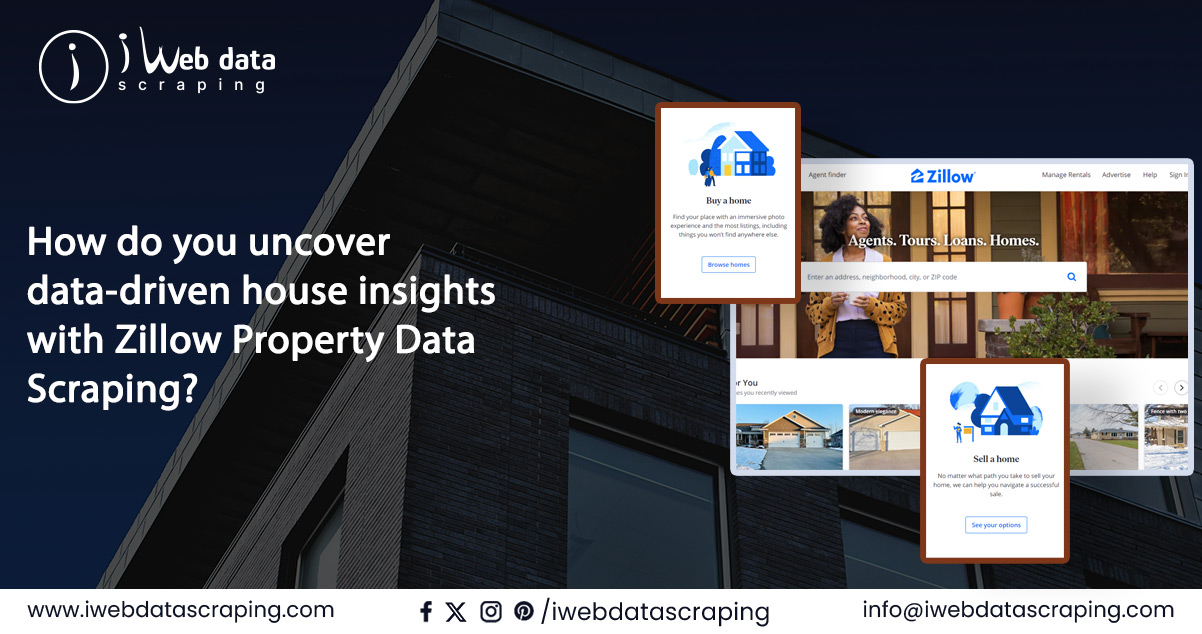
Navigating the dynamic real estate landscape requires accurate data for informed decision-making. Leveraging Zillow housing data offers profound insights into market trends, pricing dynamics, and consumer preferences.
This blog delves into the pivotal role of web scraping real estate data for market analysis, specifically focusing on the power of extracting data from Zillow. This approach empowers stakeholders with the knowledge essential for strategic decision-making.
Our analysis is based on data obtained through the Zillow Scraper, covering an extensive study of over 19,493 properties listed on Zillow in California. In the subsequent sections, we unveil the insights derived from this comprehensive exploration.
Harnessing Zillow data through property data scraping opens doors to a treasure trove of property insights, prices, features, and market trends, laying the groundwork for comprehensive real estate market analysis. Zillow Property Data Scraping empowers professionals to comprehend and anticipate pricing trends, providing crucial glimpses into the current and future dynamics of the real estate landscape.
For instance, based on our findings, in January 2023, the average home value in California commenced at 730,600 USD. Experiencing a minor dip in February and March, the values steadily ascended from April onwards. Reaching a peak in September at 750,302 USD, this data signifies an overarching upward trajectory in the state's property market throughout the year.
In real estate, a pivotal metric is the duration a property spends listed on Zillow before securing a sale. Recognized as 'Days on Market' (DOM), this timeframe is a vital indicator for real estate professionals, providing insights into the market's dynamics and buyer behavior. Understanding the 'Days on Market' offers valuable information about market conditions, helping professionals gauge the temperature of the real estate landscape.
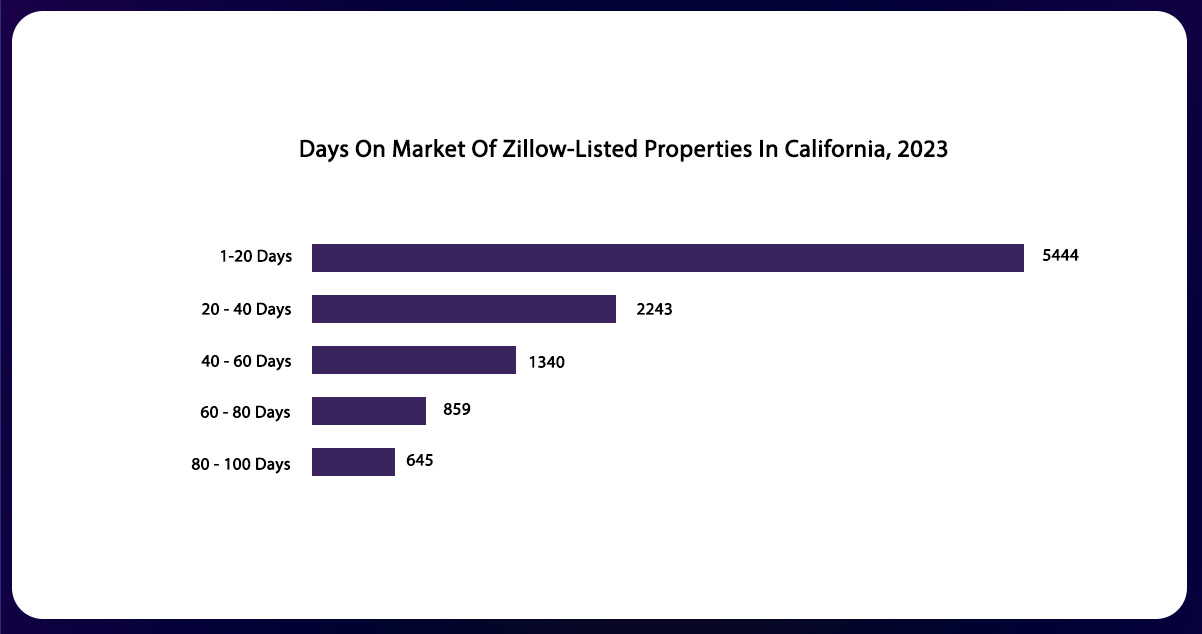
Our data analysis using real estate data scraping services unveils a compelling trend in the California real estate landscape. Many properties (5,444) undergo swift transactions, concluding within a brief period of 1 to 20 days. It emphasizes the dynamic and fast-paced nature of the state's real estate market.
This trend signifies robust buyer interest and a highly competitive market environment, where properties attract rapid attention shortly after being listed. In contrast, properties lingering on the market for extended durations become increasingly rare, hinting at potential issues or unique characteristics that limit their appeal to the broader market.
The Zestimate feature on Zillow, offering an estimated market value using a proprietary formula, is a noteworthy tool. However, our data, when juxtaposed with Zillow market reports, reveals an intriguing pattern: Zestimates often fall below the actual selling prices, adding a layer of complexity to the dynamics of property valuation on the platform.
In the dynamic realm of real estate, competitive analysis rests on the foundation of accurate and comprehensive data. Zillow housing data emerges as a critical player in this landscape. Leveraging a Real Estate Scraper facilitates extracting valuable information from Zillow, providing realtors with crucial insights into market dynamics and consumer preferences. This process enables a deeper understanding of the competitive landscape, empowering professionals to make informed decisions in a rapidly evolving real estate market.
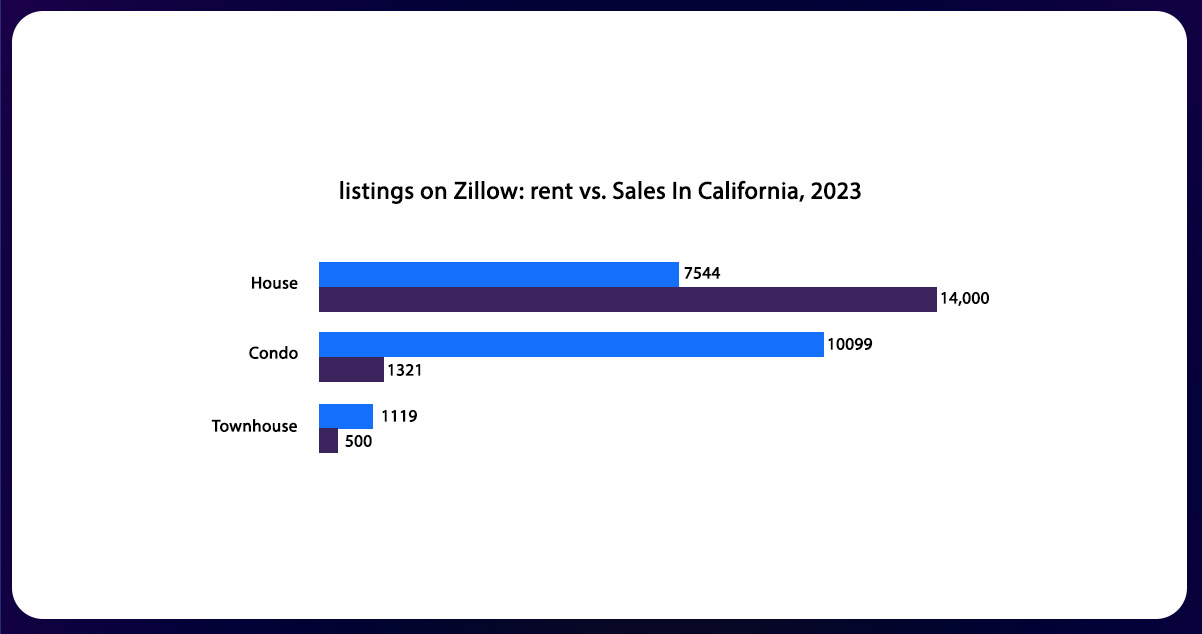
A nuanced comparison between properties available for sale and rent offers valuable insights into the underlying dynamics of the real estate market. This distinction can serve as a barometer, indicating the nature of the community—whether it leans towards stable homeownership or a more transient, renter-driven environment.
Our data analysis reveals a notable difference in the number of houses for sale (14000) compared to those for rent (7,544). This inclination toward homeownership suggests a stable and potentially family-oriented community where long-term residence and property ownership are favored.
Contrastingly, the scenario shifts when examining condos and townhouses. A significant surplus of condos available for rent (10099) compared to those for sale (1,321), along with a parallel trend in townhouses (1,119 for rent versus 500 for sale), points to a more transient, renter-driven market in these property types.
Several factors may contribute to this contrast. Condos and townhouses are perfect for temporary residents, students, or professionals seeking rental flexibility. Additionally, a strong presence of investors in these segments might indicate a strategic focus on property rental rather than immediate sales.
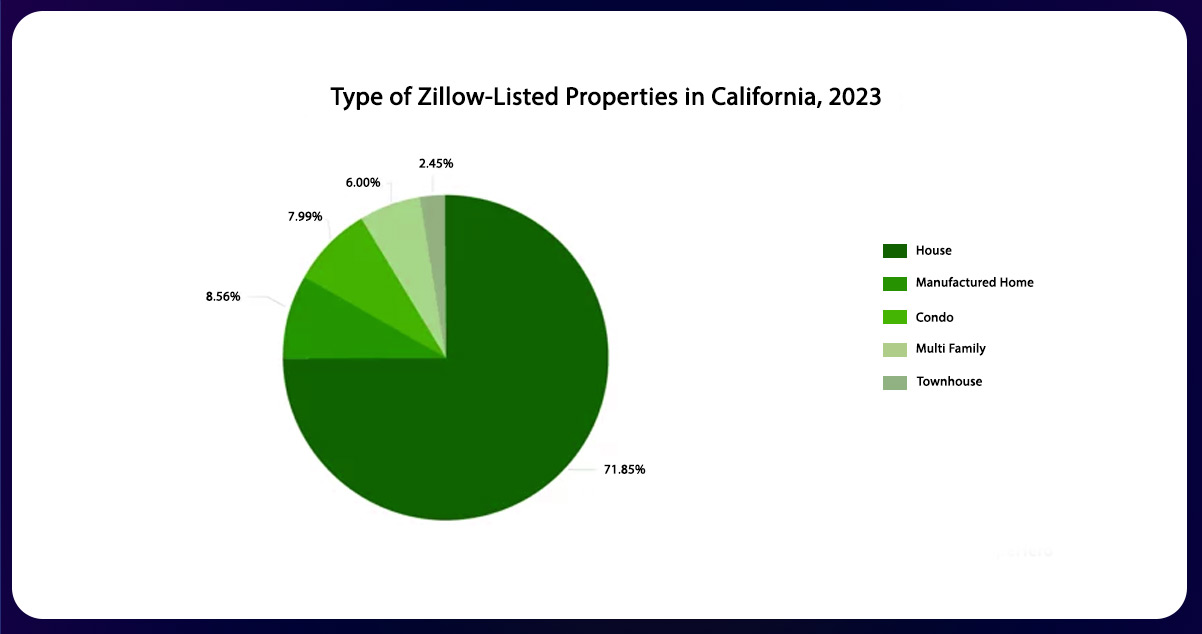
Leveraging Zillow through web scraping unveils various property types, providing a comprehensive overview of market preferences. The majority, constituting 74.86%, are regular houses, indicating a robust demand for traditional single-family homes. This preference is likely driven by the appeal of homeownership, privacy, and the desire for spacious living in a family-oriented setting.
Manufactured homes carve out a notable niche, representing 8.54% of listings, appealing to those seeking more affordable and flexible housing solutions. Condos, accounting for 8.04%, attract individuals desiring a low-maintenance lifestyle.
The presence of multi-family homes at 6.02% signals an investment opportunity in the rental market, as these properties cater to multiple tenants. Lastly, townhouses, making up only 2.52%, cater to a niche market, striking a balance between the features of single-family homes and condos.
Comparing the average prices across different property types offers a crucial perspective on market valuation, essential for understanding the distinct values associated with each property category.
In the intricate realm of real estate, property valuation stands as a foundational pillar, demanding precision and up-to-date information. Harnessing the power of a Zillow Scraper to extract data from Zillow empowers real estate professionals with the essential information needed for a thorough analysis of any property's value. This process ensures accuracy and timeliness, enabling professionals to make data-driven decisions in the rapidly evolving landscape of property valuation.
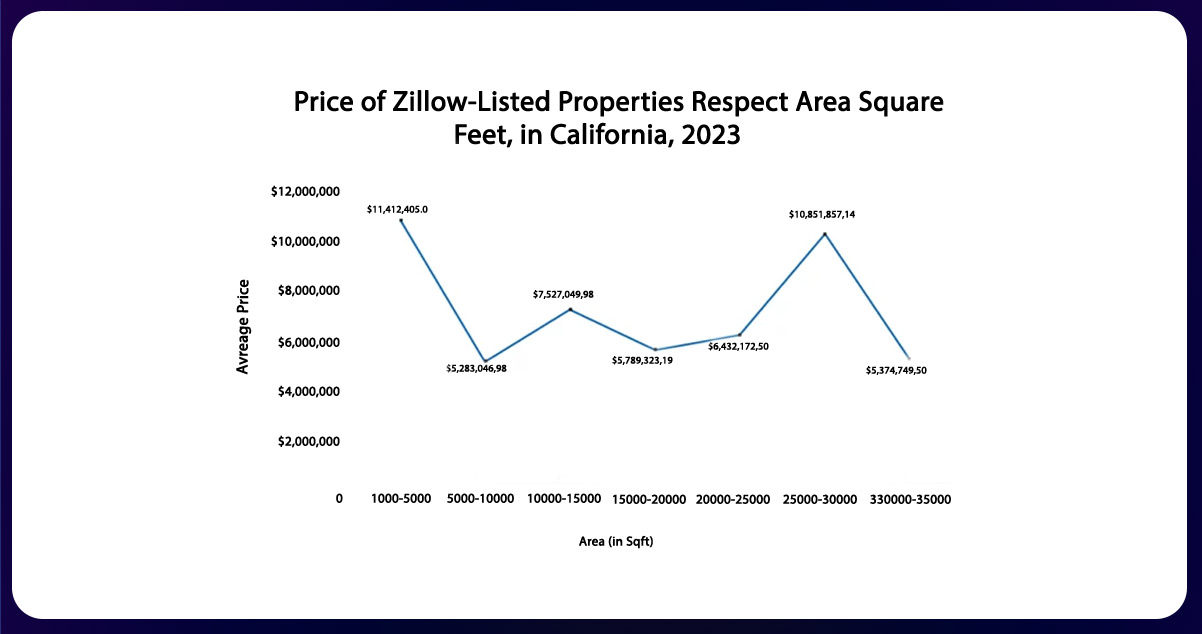
Scrape property data to get an insightful graph above, depicting the average property prices relative to square footage, unraveling the intricate relationship between property size and market value. This analysis provides invaluable insights into prevailing pricing trends derived from Zillow scraper.
Areas where more extensive properties command significantly higher prices suggest a premium on space, influencing buying and selling decisions. The 1000-5000 square feet range emerges with the highest average prices, highlighting the premium associated with properties in this size bracket. Conversely, the 5000-10,000 square feet range exhibits the lowest average prices, indicating a more affordable market segment. This nuanced understanding of size-value dynamics equips stakeholders with strategic insights in navigating the real estate landscape.
Analyzing the prices of diverse Zillow-listed properties based on the number of bedrooms is pivotal for understanding how additional bedrooms shape a property's market value. This scrutiny unveils that in markets where extra bedrooms substantially elevate property prices; there likely exists a heightened demand for family homes or rental properties tailored for larger groups. This insight sheds light on the market dynamics influenced by the number of bedrooms, providing valuable information for those navigating the complex terrain of real estate decisions.
Understanding the ever-evolving real estate market, influenced by economic shifts and consumer choices, necessitates thoroughly analyzing extensive datasets on platforms like Zillow. This exploration provides nuanced insights into the market's pulse, enabling stakeholders to make informed decisions in this dynamic landscape.
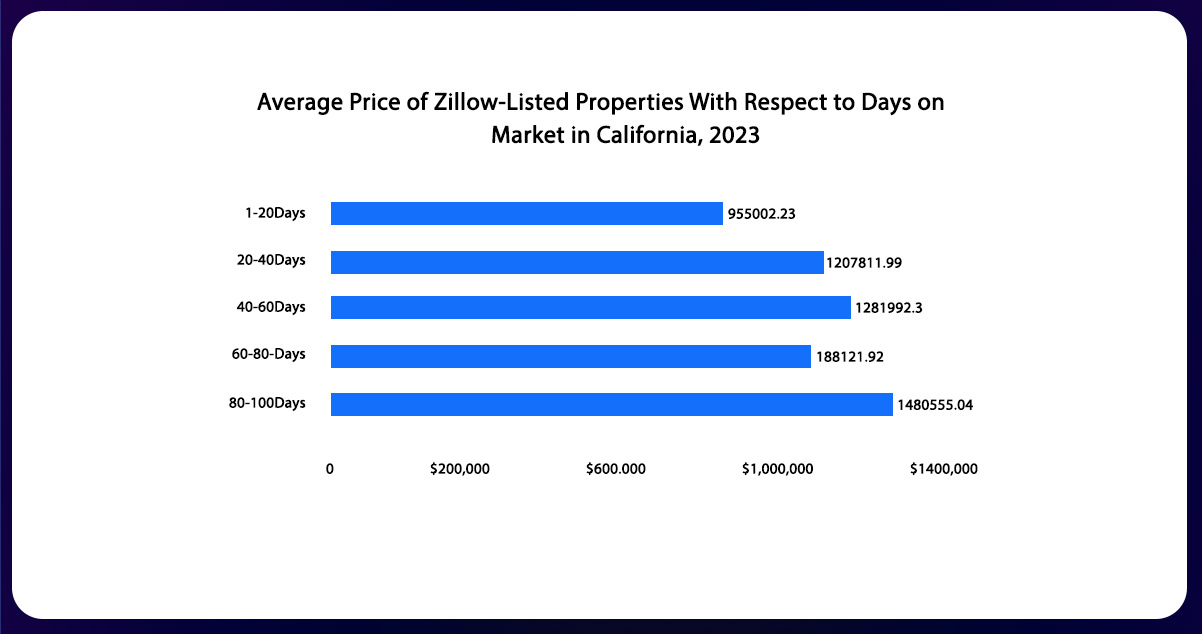
Exploring the correlation between listing duration and property prices unveils insightful nuances within the real estate market. Our data analysis reveals a swift selling pace for lower-priced properties, typically within 1 to 20 days, indicative of a robust demand for affordable homes. Conversely, higher-priced properties exhibit extended listing durations, sometimes exceeding 100 days. This trend suggests that competitively priced properties are paramount for attracting swift buyer interest, emphasizing the strategic role of pricing in navigating the intricate landscape of real estate transactions.
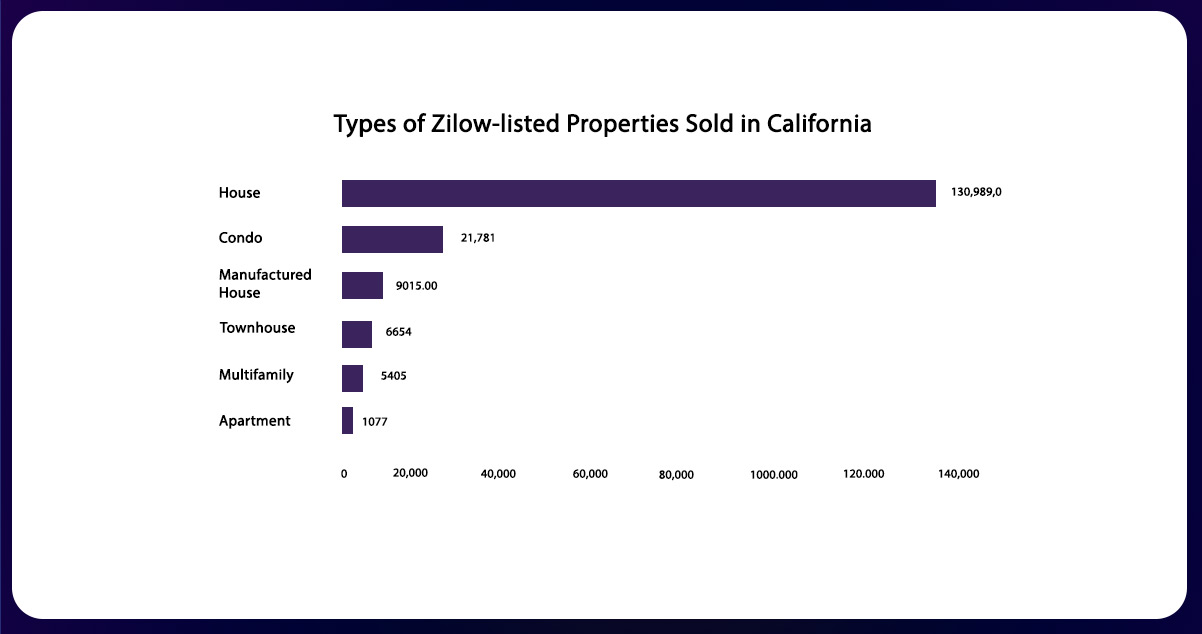
Analyzing the types of properties sold in 2023 provides vital insights into buyer preferences. Houses lead the market with approximately 130,989.00 units sold, showcasing a clear preference for traditional, spacious, and private living spaces. Condos and manufactured homes also garner significant sales, catering to diverse market segments. In contrast, apartments exhibit lower popularity, with only 1,077 units sold. These trends underscore a prevailing inclination towards more conventional and private housing options in California, with a comparatively lower interest in communal living spaces like apartments.
Conclusion: The revelations from Zillow data scraping shed light on diverse aspects of the real estate market. From dissecting pricing trends to comprehending consumer preferences and market intricacies, the data garnered through web scraping proves invaluable. It facilitates well-informed decision-making and shapes strategies in harmony with the dynamic landscape of the real estate sector.
In this journey, a Zillow crawler emerges as an indispensable tool. Providing access to an extensive pool of Zillow data equips users with the crucial information necessary to traverse the market with confidence and precision.
Please contact iWeb Data Scraping for a comprehensive range of data services! Our committed team is ready to help you, whether you need web scraping service or mobile app data scraping. Contact us today to discuss your needs for scraping retail store location data. Let us showcase how our customized data scraping solutions can deliver efficiency and reliability tailored precisely to meet your unique requirements.